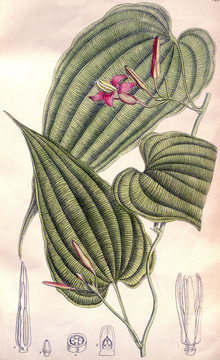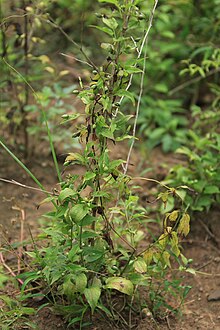
Magnolia is a large genus of about 210 to 340 flowering plant species in the subfamily Magnolioideae of the family Magnoliaceae. The natural range of Magnolia species is disjunct, with a main center in east and southeast Asia and a secondary center in eastern North America, Central America, the West Indies, and some species in South America.

Mangifera is a genus of flowering plants in the cashew family, Anacardiaceae. It contains about 69 species, with the best-known being the common mango. The center of diversity of the genus is in the Malesian ecoregion of Southeast Asia, particularly in Sumatra, Borneo, and the Malay peninsula. They are generally canopy trees in lowland rainforests, reaching a height of 30–40 m (98–131 ft).

Dalbergia is a large genus of small to medium-size trees, shrubs and lianas in the pea family, Fabaceae, subfamily Faboideae. It was recently assigned to the informal monophyletic Dalbergia clade : the Dalbergieae. The genus has a wide distribution, native to the tropical regions of Central and South America, Africa, Madagascar and southern Asia.

Curcuma is a genus of plants in the family Zingiberaceae that contains such species as turmeric and Siam tulip. They are native to Southeast Asia, southern China, the Indian Subcontinent, New Guinea and northern Australia. Some species are reportedly naturalized in other warm parts of the world such as tropical Africa, Central America, Florida, and various islands of the Pacific, Indian and Atlantic Oceans. Generally, most curcuma grows well in loose and sandy soil in shaded areas.

Argyreia is a genus of plants in the family Convolvulaceae.

Antidesma is a genus of tropical plant in the family Phyllanthaceae formally described by Linnaeus in 1753. It is native to tropical Africa, S + E + SE Asia, Australia, and various oceanic islands. The greatest diversity occurs in Southeast Asia.

Thrixspermum, commonly known as hairseeds or 白点兰属 , is a genus of flowering plants in the family Orchidaceae. Orchids in this genus are epiphytes, lithophytes or terrestrial plants with flat, leathery leaves and short-lived flowers with the sepals and petals more or less similar to each other. The labellum is rigidly fixed to the column and has three lobes. The side lobes are erect and the middle lobe is thick and fleshy. There are about 190 species distributed from tropical and subtropical Asia to the Western Pacific. Most species grow in lowland or tropical rainforests up to an altitude of 1,200 m.

Homonoia is a plant genus of the family Euphorbiaceae first described in 1790. These are rheophytes and usually found in groups at riverbanks in India, southern China, Southeast Asia, and New Guinea.
- Homonoia intermediaHaines - India
- Homonoia retusa Müll.Arg. - India, Vietnam
- Homonoia riparia Lour. - Guangxi, Guizhou, Hainan, Sichuan, Taiwan, Yunnan, Cambodia, India, Assam, Bhutan, Sri Lanka, Borneo, Java, Lesser Sunda Islands, Sulawesi, Sumatra, Maluku, Laos, Malaysia, Myanmar, Philippines, Thailand, Vietnam, New Guinea, Andaman & Nicobar Islands

Triadica is a plant genus of the family Euphorbiaceae first described as a genus in 1790. It is native to eastern southeastern, and southern Asia.

Sterculia is a genus of flowering plants in the mallow family, Malvaceae: subfamily Sterculioideae. Members of the genus are colloquially known as tropical chestnuts. Sterculia may be monoecious or dioecious, and its flowers unisexual or bisexual.

Galeola is a genus of orchids belonging to the subfamily Vanilloideae.

Phoebe is a genus of evergreen trees and shrubs belonging to the Laurel family, Lauraceae. There are 75 accepted species in the genus, distributed in tropical and subtropical Asia and New Guinea. 35 species occur in China, of which 27 are endemic. The first description of the genus was of the type species P. lanceolata made in 1836 by Christian Gottfried Daniel Nees von Esenbeck in Systema Laurinarum, p. 98.
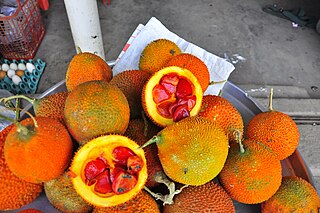
Gac, from the Vietnamese gấc, scientific name Momordica cochinchinensis, is a species of plant in the melon and cucumber family Cucurbitaceae which is native to countries throughout Southeast Asia and to Queensland, Australia. It is notable for its vivid orange-reddish color resulting from its rich content of beta-carotene and lycopene.

Buchanania cochinchinensis, commonly known as charoli nut, almondette, Cuddapah almond, calumpong, Hamilton mombin, is a deciduous tree of the cashew family. The charoli tree is native to the Indian subcontinent, South Central China, and much of Southeast Asia.

Flemingia is a genus of plants in the family Fabaceae. It is native sub-Saharan Africa, Yemen, tropical Asia, and Australasia. In Asia the species are distributed in Bhutan, Burma, China, India; Indonesia, Laos, Malaysia, Nepal, Pakistan, Papua New Guinea, Philippines, Sri Lanka, Taiwan, Thailand and Vietnam. The genus was erected in 1812.

Phanera is a genus of flowering plants in the legume subfamily Cercidoideae and the tribe Bauhinieae. This genus differs from Bauhinia in being vines or lianas, generally with tendrils and a lobed rather than spathaceous calyx, and from Schnella in having only three fertile stamens rather than ten, and being native to the Indomalayan realm and the Australasian realm rather than the Americas. The subsection Corymbosae was recently segregated into a new genus, Cheniella. It has been suggested that the genus Lasiobema should be reduced to a section within Phanera.
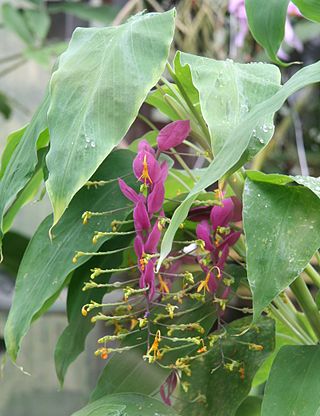
Globba is a genus of plants in the ginger family. It contains about 100 species, native to China, the Indian Subcontinent, Southeast Asia, New Guinea, the Bismarck Archipelago and Queensland.
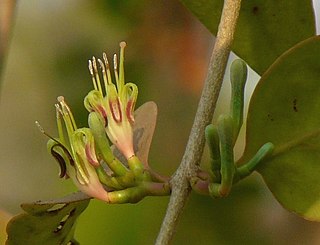
Macrosolen is a genus of plants in the family Loranthaceae. It includes about 83 species all over the world with ca. 40 species widely distributed in tropical South and Southeast Asia. Some species were described by de Loureiro, Lecomte, Danser (1938) and Hô (2003).

Flupyradifurone is a systemic butenolide insecticide developed by Bayer CropScience under the name Sivanto. Flupyradifurone protects crops from sap-feeding pests such as aphids and is safer for non-target organisms compared to other insecticides. Sivanto was launched in 2014 since it obtained its first commercial registration in central America. Insecticide Resistance Action Committee (IRAC) classified Flupyradifurone as 4D subset (butenolide) and it is the first pesticide in the butenolide category. It was approved by European Union in 2015.
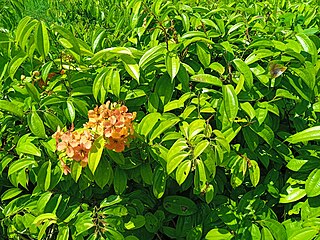
Phanera coccinea is the type species of the genus Phanera: a "climbing shrub" in the subfamily Cercidoideae and the tribe Bauhinieae, the genus having been separated from Bauhinia. Under its synonym Bauhinia coccinea, its Vietnamese names include "quạch" and "mấu". Records of distribution exist from the subtropical and tropical forests of Indochina and South-central China.
